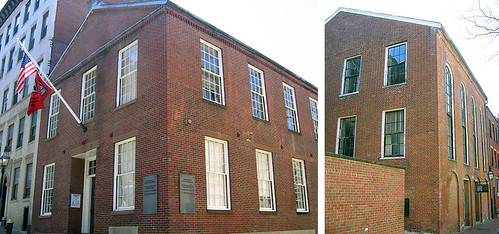A History of Segregation in the Boston Public Schools
Origins
Racial imbalance in the Boston Public Schools is not a recent phenomenon. In 1798, an African American abolitionist in the city named Primus Hall opened the “African School,” at his home in the Beacon Hill neighborhood of Boston. Hall opened this school as an alternative means of education for African American children of the city who did not wish to be around the prejudices and discrimination associated with the schools white children attended. The school remained in Hall’s house until 1806 when it moved the basement of the African Meeting House, a recently built Baptist Church in Boston at this time. The school remained in this location until the establishment of the Abiel Smith School in 1835. These two buildings are still standing in Boston today. Starting in 1815, however, the African School fell out of private hands and under the jurisdiction of the Boston General School Committee. At this point, the School Committee began the construction of schools for African Americans throughout the city, leading to the practice of segregation in the Boston Public Schools.
Above: The Abiel Smith School (left) and the African Meeting House (right). Both buildings were home to Primus Hall's African School. The Abiel Smith School also played a part in the case Roberts v. City of Boston. Source
Roberts v. City of Boston (1850)
In 1849, the Boston General School Committee denied Sarah Roberts, a five-year-old African American student, admission into the public school closest to her house. Instead, the Committee assigned her to the Abiel Smith School, which had become a poorly funded school composed of other African Americans across the city. Sarah’s father, Benjamin F. Roberts, sued the Boson General School Committee on the behalf of Sarah, claiming that the Committee deprived his daughter of an education when they sent her to, in his view, an inferior school. The Massachusetts Superior Court heard the case Roberts v. City of Boston and handed down their decision in 1850. The Court ruled in favor of the Committee, saying that, since a substantial equality of resources existed between white and black schools, the committee was acting within its powers:
"It is urged, that this maintenance of separate schools tends to deepen and perpetuate the odious distinction of caste, founded in a deep-rooted prejudice in public opinion. This prejudice, if it exists, is not created by the law, and probably cannot be changed by the law.” [1]
Roberts eventually petitioned the state legislature to take action, and in 1855 Massachusetts passed a law banning segregated schools. At this point, however, the damage was already done. The Roberts v. City of Boston decision was cited heavily in the 1896 Supreme Court case Plessy v. Ferguson, which established the standard of "separate but equal." [2]
While it is true that Massachusetts banned segregated schools in 1855, that is not the whole story; the state banned de jure segregation. "De jure (literally “from law”) segregation happens when laws are created that force and enforce the segregating of races in public spaces. In Boston, laws did not enforce the separation of races; however, segregation still existed in the city. De facto (literally "in fact") segregation often exists in a city where neighborhoods are divided upon racial and ethnic lines due to the settlement of its citizens. In addition, some cities, such as Boston, maintained a policy of sending school children to the school nearest to their homes. A combination of these two factors result in a perfectly legal system where many schools are comprised of predominately African American or predominately white students. In de facto segregated systems, all children are part of the same school system, and are funded and staffed by the same school department. In this type of system, some schools are minimally integrated, and the academic staff are not generally segregated. This pattern of de facto segregation followed the residents of Boston well into the 1960s where our story begins. [3]



